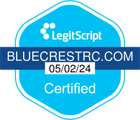 Although there has been increasing acceptance and legalization of marijuana use in some states, the drug still poses a risk for abuse and addiction. Millions of people in the United States meet the diagnostic criteria for a marijuana use disorder. Fortunately, you can avail of a marijuana addiction treatment program in New Jersey at BlueCrest Recovery. Contact our marijuana rehab center today at 888.292.9652 to learn more about our options for substance abuse treatment in New Jersey.
Although there has been increasing acceptance and legalization of marijuana use in some states, the drug still poses a risk for abuse and addiction. Millions of people in the United States meet the diagnostic criteria for a marijuana use disorder. Fortunately, you can avail of a marijuana addiction treatment program in New Jersey at BlueCrest Recovery. Contact our marijuana rehab center today at 888.292.9652 to learn more about our options for substance abuse treatment in New Jersey.
What is marijuana?
Marijuana comes from the plant Cannabis sativa. The primary psychoactive compound is delta-9-tetrahydrocannabinol (THC), which delivers the “high” that many users value. Marijuana is typically smoked, vaped, eaten, sprayed under the tongue, taken by tincture, absorbed through the skin, or taken by pill.
More than 10 U.S. states have legalized marijuana for both medical and recreational use. Medical, but not recreational, use of marijuana is legal in many additional states. Medical marijuana is prescribed by a doctor to treat health symptoms or conditions.
What are the Effects of Marijuana?
THC and other chemical compounds in marijuana interact with the body’s chemical messengers to signal and activate areas of the brain that control pleasure, movement, memory, sensory perception, and an altered sense of time. Users typically describe a deep understanding of relaxation and a heightened sense of fun. When marijuana is smoked, the effects are felt quickly as the chemicals rush through the lungs into the bloodstream. Consuming marijuana in edibles or drinks takes longer to feel the effects, as the chemicals must first move through the digestive system before reaching the bloodstream.
The effects of marijuana are not always pleasurable. This can especially be a problem when consuming edibles. Because it can take up to four hours to experience the full effects of an edible, users may become impatient and continue to ingest more, resulting in too great of a dose. This can cause an intense, possibly frightening high. Other symptoms that may result from using too much marijuana include:
- Extreme confusion
- Paranoia
- Panic
- Fast heart rate
- Increased blood pressure
- Severe nausea or vomiting
Any of these effects can contribute to unintentional injuries, including motor vehicle crashes, falls, or poisoning.
Can you Become Addicted to Marijuana?
Just because many states have legalized or are in the process of legalizing marijuana does not mean there is no risk of harm, abuse, or addiction resulting from its use. Although many patients and doctors strongly believe in its therapeutic effects, many adverse health effects are associated with marijuana use, including the risk of addiction. Problem use of marijuana is defined as a marijuana use disorder. Although it’s not labeled as “addiction,” those with marijuana use disorder exhibit addictive behaviors.
What is Marijuana Use Disorder?
Physicians use the Diagnostic and Statistical Manual (DSM-5) to diagnose substance use disorders (SUDs). The DSM-5 recognizes 10 categories of substance use disorder, one of which is marijuana use disorder. The criteria used by the DSM-5 to diagnose and rank the severity of a marijuana use disorder are the same criteria used for any SUD.
Frequent users of marijuana often experience withdrawal symptoms when they stop taking it, which may include mood changes, irritability, restlessness, sleeping disorders, cravings, and other forms of discomfort.
How Does a Marijuana Addiction Treatment Program Work?
 Marijuana use disorder often co-occurs with other SUDs and behavioral and mental issues. People struggling with marijuana use disorder, particularly those with severe forms of the condition, experience considerable mental disability, and often these disabilities persist even after treatment at a marijuana addiction treatment center.
Marijuana use disorder often co-occurs with other SUDs and behavioral and mental issues. People struggling with marijuana use disorder, particularly those with severe forms of the condition, experience considerable mental disability, and often these disabilities persist even after treatment at a marijuana addiction treatment center.
Marijuana use disorder may be treated in an inpatient treatment setting or by attending an outpatient treatment program. The program usually includes individual, group, and family therapy sessions and education on addiction, recovery, and preventing relapse. Many treatment programs utilize a 12-step approach to recovery.
Services Offered
Assessment and Diagnosis
During the assessment and diagnosis phase of marijuana addiction treatment, a comprehensive evaluation is conducted to understand the individual’s addiction history, mental health status, and any co-occurring disorders. This helps in developing an individualized treatment plan that addresses specific needs and challenges.
Individual Therapy
Our individual therapy involves one-on-one sessions between the individual and a therapist or counselor specializing in addiction treatment. It provides a safe and confidential space for the individual to explore their thoughts, feelings, and behavioral patterns related to marijuana addiction. Our therapist helps identify and address the underlying factors contributing to addiction and develop coping strategies for relapse prevention and recovery.
Group Therapy
Group therapy involves participating in therapy sessions with a small group of individuals who are facing similar challenges with marijuana addiction. These sessions promote peer support, sharing experiences, and learning from others’ perspectives. Group therapy offers a sense of community, reduces isolation, and provides opportunities for practicing healthy communication and interpersonal skills.
Family Therapy
Our family therapy involves the participation of family members in the treatment process. It aims to improve communication, rebuild trust, and address the impact of marijuana addiction on family dynamics. Family therapy helps create a supportive and understanding environment for the individual in recovery and facilitates a comprehensive approach to healing the entire family system.
Aftercare Planning and Support
After completing a marijuana addiction treatment program, our aftercare planning and support play a crucial role in maintaining long-term recovery. This can involve creating a comprehensive aftercare plan, linking individuals to support groups or community resources, providing ongoing therapy or counseling, and ensuring access to relapse prevention services. Aftercare support helps individuals transition back into their daily lives with the necessary tools and support to maintain sobriety.
What Makes Our Services Unique
- Individualized Treatment Programs. Our programs are customized to each client’s unique situation and needs, ensuring a personalized and effective path to recovery.
- Co-Occurring Disorder Treatment. We recognize that substance use disorders often exist alongside other mental health conditions, so our treatments address these comorbid disorders for holistic healing.
- Therapeutic Approach. We provide individual, group, and family therapy sessions as part of our comprehensive care, fostering growth and support both individually and within the patient’s social circle.
- Education-Focused. We strongly believe in empowering patients through education on addiction, the recovery process, and strategies to prevent relapse, supplementing our clinical treatments with knowledge and understanding.
- Accessibility. Available at the push of a button, potential patients could instantly connect with our addiction specialists, simplifying the process of seeking help.
- Experienced Team of Professionals. Our team consists of professionals with extensive knowledge and experience in managing marijuana addiction; their expertise ensures the highest quality of care for each patient.
Find Marijuana Addiction Treatment in New Jersey at BlueCrest Recovery
BlueCrest Recovery’s marijuana rehab center in New Jersey develops an individualized addiction treatment plan to meet each client’s specific needs. It includes treatment of co-occurring disorders in the plan. Our compassionate team of experts is committed to your recovery and will guide you every step of the way toward completing your treatment program. We are dedicated to helping you achieve sobriety and improve your overall health and well-being.
Contact our team today at 888.292.9652 to learn more.





